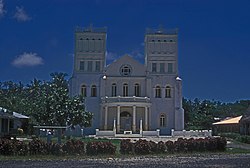
Lealataua County is a county in the Western District in American Samoa. [1] [2] [3]

Lealataua County is a county in the Western District in American Samoa. [1] [2] [3]
In May 1956, the Aliʻi (High Chief) and tulafale (High Talking Chief) of Lealataua County were unable to reach a consensus on a single candidate for county chief. Consequently, Governor Richard Barrett Lowe intervened by setting a deadline for their discussions, requiring them to submit the names of all eligible and qualified candidates still under consideration by the county council. [4]
| Year | Pop. | ±% |
|---|---|---|
| 1912 | 1,163 | — |
| 1920 | 1,134 | −2.5% |
| 1930 | 1,256 | +10.8% |
| 1940 | 1,625 | +29.4% |
| 1950 | 2,201 | +35.4% |
| 1960 | 2,393 | +8.7% |
| 1970 | 3,145 | +31.4% |
| 1980 | 3,581 | +13.9% |
| 1990 | 5,106 | +42.6% |
| 2000 | 5,684 | +11.3% |
| 2010 | 5,103 | −10.2% |
| 2020 | 4,293 | −15.9% |
| U.S. Decennial Census [5] | ||
Lealataua County was first recorded beginning with the 1912 special census. Regular decennial censuses were taken beginning in 1920. [6]


14°20′38″S170°47′06″W / 14.34389°S 170.78500°W